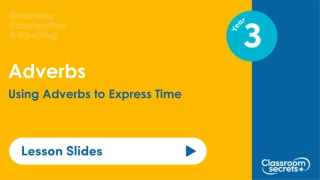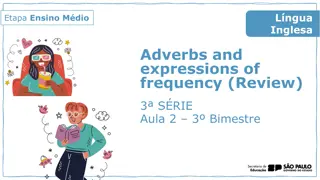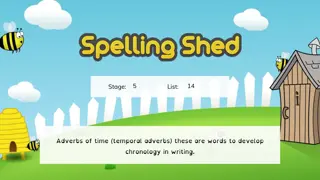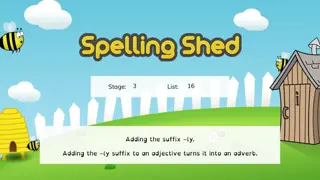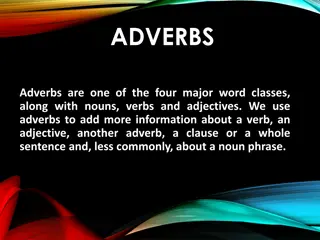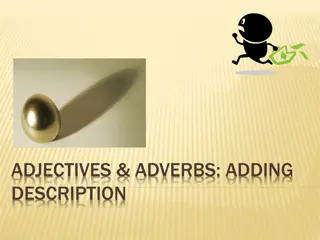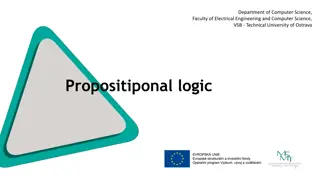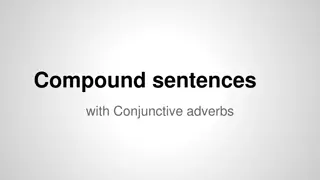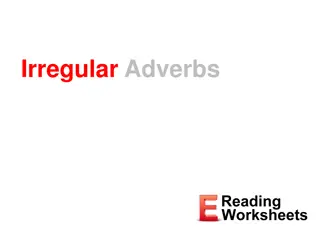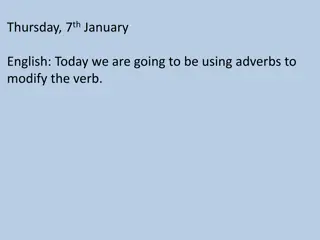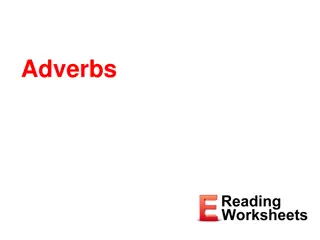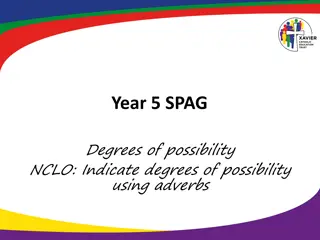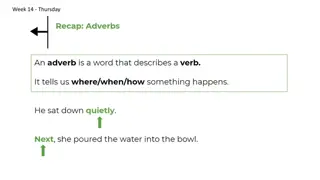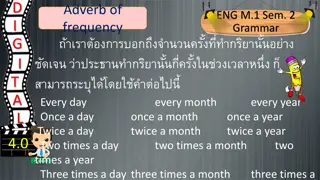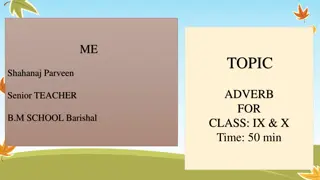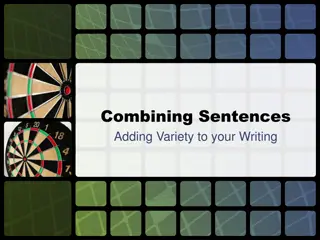Adverbs and Adverbials of Frequency: How Often Do You...?
This lesson focuses on the usage of the question "How often?" and adverbs/adverbials of frequency. Students will learn where to place them in a sentence and how to accurately use them. The lesson also provides examples and practice exercises.
4 views • 12 slides
Understanding Adverbs: Expressing Time in Language
Explore the role of adverbs in expressing time, differentiate between adverbs of manner and adverbs of time, and practice identifying and using adverbs in sentences. Learn how adverbs provide additional context to actions and discover examples of adverbs of time. Enhance your understanding of how ad
4 views • 42 slides
Learning Adverbs, Comparatives, and Superlatives in English Grade 6 Lesson 3
Enhance your English skills in Grade 6 with Lesson 3 on adverbs of frequency, comparative and superlative forms, and possessive pronouns. Practice choosing the correct adverbs, filling in the gaps with adjectives, and mastering the use of quantifiers. Improve your language proficiency and expand you
8 views • 12 slides
Adverbs and Expressions of Frequency in English
Reviewing adverbs and expressions of frequency in English language for oral and written text production. Focus on types of relationships and grammar. Activities to analyze sentences and frequency indicators. Overview of common adverbs and expressions used to express regularity.
4 views • 20 slides
Understanding Notional Parts of Speech: Adjectives and Adverbs
Exploring the notional parts of speech, this text delves into the properties and functions of adjectives and adverbs. Adjectives describe the qualities of substances, while adverbs characterize actions or qualities. Adjectives can be qualitative or relative, with degrees of comparison, while adverbs
1 views • 25 slides
Exploring Adverbs of Time in Writing
Dive into the world of adverbs of time to enhance chronology in writing. Discover various temporal adverbs, engage in a fun spelling activity, and craft sentences using these words to develop a better understanding of time frames within your writing.
1 views • 5 slides
Transforming Adjectives into Adverbs by Adding the -ly Suffix
Explore the process of converting adjectives into adverbs by adding the -ly suffix. Understand how this simple change alters the meaning of words and enhances sentence construction. Engage in educational activities to practice this concept effectively.
0 views • 8 slides
Understanding Adverbs: Usage and Placement
Adverbs play a crucial role in enhancing the information provided by verbs, adjectives, and other adverbs in a sentence. They can indicate when, where, or how an action is performed, or express the quality or degree of an action. It is important to correctly place adverbs in a sentence to avoid chan
0 views • 9 slides
Understanding Adjectives and Adverbs: Rules and Examples
Enhance your grammar skills by learning about adjectives and adverbs. Adjectives modify nouns and pronouns to describe what kind of person, place, or thing, while adverbs modify verbs by expressing manner, place, time, degree, or number. Explore different types of adverbs and examples to grasp their
0 views • 14 slides
Understanding Adjectives and Adverbs for Descriptive Writing
Learn how adjectives and adverbs enhance writing by adding specific details about people, objects, and actions. Adjectives modify nouns to make sentences more descriptive, while adverbs provide additional information about verbs or adjectives. Discover the importance of using these descriptive words
0 views • 26 slides
Understanding Normal Forms in Propositional Logic
Explore the concept of normal forms in propositional logic, where each formula has a unique truth-value function. Learn about equivalence of formulas, determining normal forms, and canonic forms like Disjunctive Normal Form (DNF) and Conjunctive Normal Form (CNF). Discover how to find canonic forms
1 views • 22 slides
Understanding Adverbs and Adverbials in English Grammar
Adverbs modify various elements in a sentence, such as verbs, adjectives, and even whole clauses. Not all adverbs end in "ly," and they can belong to categories like time, place, degree, and discourse markers. Adverbials are strings of words that modify functions, including prepositional phrases, no
1 views • 9 slides
Learn to Use Adverbs in Independent Writing for Year 1 English
Explore the world of adverbs with engaging activities like identifying adverbs in sentences and using them creatively in independent writing. Enhance language skills as you describe actions with adverbs like quietly, cheerfully, skillfully, and more. Access lesson materials and practice adverbs with
0 views • 15 slides
Mastering Adverbs of Manner: Transforming Adjectives into Adverbs
Welcome to week 13 where we delve into Adverbs of Manner. Learn the rules of transforming adjectives into adverbs effortlessly, with examples and visual aids. Understand the nuances between adjectives and adverbs, and practice adding -ly, changing -y to -i and more. Engage actively and enhance your
0 views • 15 slides
Understanding Adjectives and Adverbs Usage in English
Exploring the correct usage of adjectives and adverbs in English grammar, covering topics such as when to use adjectives vs. adverbs, how to describe actions and linking verbs, and the importance of proper comparisons. Examples and explanations provided to enhance understanding.
0 views • 6 slides
A Guide to Using Conjunctive Adverbs in Compound Sentences
A conjunctive adverb is an adverb used to connect clauses or parts of a sentence. When joining compound sentences with conjunctive adverbs, use a semicolon and a comma. Examples and guidelines are provided for proper usage. Practice formulating compound sentences with conjunctive adverbs to enhance
0 views • 7 slides
Understanding Irregular Adverbs in English Grammar
Explore irregular adverbs, flat adverbs, irregular adverbs of degree, negatives as adverbs, and the difference between "good" and "well" in English grammar. Learn how irregular adverbs modify verbs, adjectives, and other adverbs, with examples and visual aids provided.
0 views • 11 slides
Understanding Adjectives and Adverbs as Modifiers in English
Explore the role of adjectives and adverbs as modifiers in English language. Learn how adjectives describe nouns and pronouns, while adverbs modify adjectives, verbs, or other adverbs to show how, where, when, or to what degree an action is done. Understand the difference between adjectives and adve
0 views • 21 slides
Mastering Adverbs of Frequency for Daily Activities
Learn how to use adverbs of frequency to describe the frequency of daily activities with examples like playing the guitar, reading a book, running, and going to the cinema. Understand the usage of adverbs like always, usually, often, sometimes, rarely, and never in expressing routine actions. Improv
0 views • 18 slides
Understanding Adjectives and Adverbs Usage: Common Errors and Differences
Adjectives modify nouns and pronouns, while adverbs modify verbs, adjectives, and other adverbs. Learn the differences, common errors, and how to distinguish between commonly confused adjective/adverb pairs like real/really and sure/surely. Enhance your understanding of when to use each correctly.
0 views • 7 slides
Mastering Semicolon Usage: Rules and Examples
Learn how to effectively use semicolons with clear rules and examples. Discover when to replace a period with a semicolon, how to use it with conjunctive adverbs, and the Super Comma Rule for lists. Practice with provided examples to enhance your writing skills.
0 views • 5 slides
Enhancing English Grammar Skills Through Connecting Clauses
Today's agenda in English class includes a grammar review on connecting clauses, writing a story review, and preparation for a group presentation. The lesson covers different types of connectors like coordinators, conjunctive adverbs, and subordinators. Various examples and exercises are provided to
0 views • 18 slides
Understanding Adjectives, Adverbs, and Linking Verbs in Writing
Learn about the significance of linking verbs in expressing a state of being, the role of adjectives in modifying nouns, and the function of adverbs in modifying verbs, adjectives, and adverbs. Explore examples of using "bad" and "badly," as well as "good" and "well" correctly. Test your understandi
0 views • 8 slides
Understanding Adverbs by Using Them in Sentences
Learn about adverbs and how they modify verbs through examples and exercises. Practice identifying adverbs in sentences and create your own sentences using adverbs to describe actions. Enhance your English language skills in a fun and interactive way.
0 views • 9 slides
Understanding Adverbs: Usage and Examples
Explore the role of adverbs in modifying verbs, adjectives, and other adverbs. Learn how to turn adjectives into adverbs, differentiate between "good" and "well," and use adverbs in sentences correctly. Discover common examples and get insights into how adverbs enhance the clarity and effectiveness
0 views • 10 slides
Understanding Adverbs in English Grammar
Delve into the world of adverbs with this presentation created by Stephens Luke Malaker, Principal of PRAN-RFL PUBLIC SCHOOL. Learn about how adverbs modify verbs, adjectives, and other adverbs. Explore examples and understand the various ways adverbs can modify verbs. Discover the position of adver
0 views • 34 slides
Understanding Adverbs and Their Types
Adverbs play a crucial role in modifying verbs, adjectives, and other adverbs to express various qualities or circumstances. They can be confused with adjectives but serve different purposes by indicating time, place, manner, or quality in a more concise manner. Adverbs are classified into categorie
0 views • 16 slides
Understanding Degrees of Possibility Using Adverbs
Explore the concept of degrees of possibility in English grammar by using adverbs. Learn about different types of adverbs, how to indicate degrees of possibility using adverbs, and examples of adverbs that show varying levels of certainty. Discover modal verbs that can also express different levels
0 views • 7 slides
Understanding Adverbs of Possibility and Probability
Adverbs of possibility and probability indicate the likelihood of an action or state occurring. They include words like "certainly," "indeed," "perhaps," "probably," and "maybe." These adverbs can be positioned at the beginning of a clause or before the main verb, depending on the context. Understan
0 views • 5 slides
Recognizing Adverbs of Time, Manner, and Place in Sentences
This learning material provides images of words, prompting the identification of adverbs of time, manner, and place. Students are tasked with categorizing each adverb in the correct section of a grid to enhance their understanding of different types of adverbs.
0 views • 5 slides
Understanding Adverbs: Types and Functions Explained
Adverbs modify verbs, adjectives, or other adverbs in a sentence, providing information about time, manner, place, or degree. Learn about different types of adverbs - Time, Manner, Place, and Degree - with examples and their functions. Discover how adverbs enhance the meaning of a sentence with word
0 views • 19 slides
Mastering Adverbs and Adverbials: A Comprehensive Guide
Enhance your understanding of adverbs and adverbials with visual aids and practice exercises. Learn how adverbs describe verbs and adverbials provide details about when, where, or how actions occur. Practice identifying and using adverbs and adverbials in sentences with the help of provided sheets.
0 views • 8 slides
Understanding Adverbs in English Grammar
Explore the world of adverbs in English grammar through this comprehensive guide. Learn how adverbs describe actions and their various forms, including regular and irregular adverbs. Discover how adverbs can have the same form as adjectives and how intensifiers like "very" and "really" enhance the s
0 views • 48 slides
Understanding Adverbs of Frequency in English Language Studies
Explore the usage of adverbs of frequency such as "every day," "twice a month," and "once a week" in English grammar through exercises and examples. Enhance your understanding of how to construct sentences using present simple tense to describe regular activities. Practice placing adverbs in sentenc
0 views • 53 slides
Understanding Quantity with Adverbs: Too, Enough in English Grammar
Learn about using adverbs to express quantity in English grammar with examples of using "too" and "enough" in different contexts. Discover how these adverbs modify verbs, adjectives, and nouns to convey varying degrees of abundance or insufficiency.
0 views • 12 slides
Understanding Adverbs: Lesson for Class IX & X By Senior Teacher Shahanaj Parveen
In this lesson led by Senior Teacher Shahanaj Parveen from B.M. School in Barishal, students will grasp the definition of adverbs, learn about their positioning, and practice using adverbs in real-life scenarios. The aim is to enhance students' understanding of this essential part of speech through
0 views • 21 slides
Correcting Common Comma Splice Errors in Writing
Learn how to identify and fix comma splices with helpful examples and guidelines. Understand the incorrect use of commas to join independent clauses and discover multiple solutions such as separating sentences, using semicolons, adding conjunctions, or employing conjunctive adverbs. Enhance your wri
0 views • 7 slides
Enhancing Writing with Sentence Combination Techniques
Explore the art of combining sentences to add variety and engage readers effectively. Learn about coordinating, subordinating, and correlative conjunctions, as well as conjunctive adverbs. Discover how combining sentences can prevent monotony, captivate your audience, and elevate the overall quality
0 views • 49 slides
Understanding Adverbs: A Comprehensive Lesson
Today's lesson focuses on adverbs, describing how, where, or when something is done. The students will learn about different kinds of adverbs, their formation from adjectives, functions, and examples of adverbs of place and frequency. The lesson aims to improve the students' understanding of adverbs
0 views • 14 slides
Understanding Adverbs: Usage, Formation, and Placement in Sentences
Adverbs are essential in describing how an action is performed. They are formed by adding "ly" to adjectives and can also have various forms. Their placement in a sentence can significantly impact the meaning. This comprehensive guide covers the formation, usage, and positioning of adverbs, along wi
0 views • 11 slides

